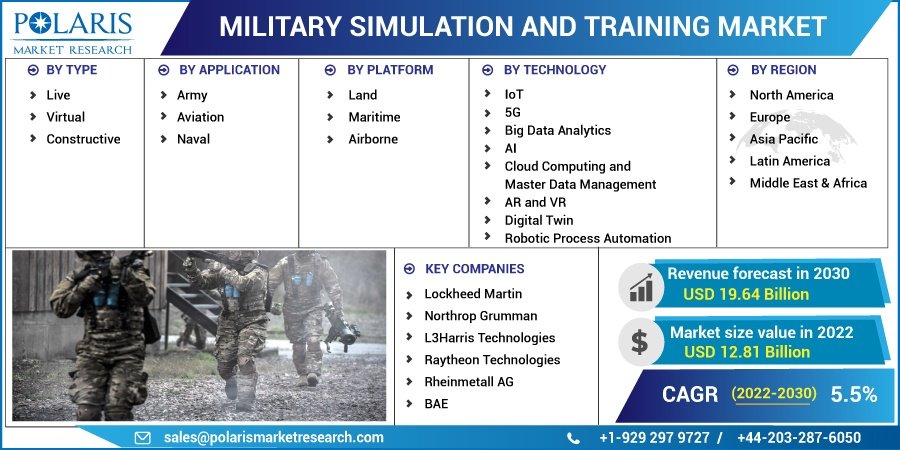Military simulation and training Market size is anticipated to grow USD 19.64 billion by 2030, exhibiting the CAGR of 5.5% during the forecast period.
Military simulation and training refer to the use of advanced technologies such as virtual reality (VR), augmented reality (AR), artificial intelligence (AI), and high-fidelity simulators to enhance military preparedness and operational effectiveness. These solutions allow defense forces to conduct cost-effective, risk-free training exercises replicating real-world combat scenarios. The global military simulation and training market is witnessing significant growth, driven by increasing defense budgets, technological advancements, and the need for efficient training solutions.
Market Growth Drivers
Several factors are propelling the expansion of the military simulation and training market:
- Rising Defense Budgets: Governments worldwide are increasing their military spending to enhance operational readiness, thereby boosting investments in simulation and training solutions.
- Technological Advancements: Innovations in AI, VR, AR, and machine learning are making simulations more immersive and realistic, improving training effectiveness.
- Cost-Effectiveness: Simulation-based training reduces the need for live training exercises, cutting costs associated with ammunition, fuel, and logistics.
- Enhanced Safety Measures: Simulations provide a safe environment for soldiers to train in high-risk scenarios without real-world consequences.
- Increasing Geopolitical Tensions: Rising security threats and border conflicts are pushing nations to enhance military training programs.
- Demand for Remote Training: The COVID-19 pandemic accelerated the adoption of remote and digital training solutions, which continues to drive market growth.
Key Trends in Military Simulation and Training
- Integration of AI and Machine Learning: AI-driven simulations enhance decision-making, adaptive learning, and predictive analysis, improving training outcomes.
- Rise of Virtual and Augmented Reality: VR and AR technologies are transforming military training by providing highly immersive and interactive experiences.
- Cloud-Based Simulation Solutions: Cloud computing enables real-time access to training modules, improving flexibility and scalability.
- Live-Virtual-Constructive (LVC) Training: A hybrid approach combining live exercises, virtual simulations, and constructive scenarios is gaining traction.
- Use of Cybersecurity Simulations: With growing cyber threats, military forces are increasingly investing in cyber warfare training solutions.
- Adoption of 5G Technology: High-speed connectivity enhances real-time data transmission, improving the effectiveness of simulation-based training.
Research Scope
The research scope of the military simulation and training market includes:
- Technology Analysis: Examining advancements in AI, VR, AR, cloud computing, and cybersecurity training.
- Regional Analysis: Studying market trends across North America, Europe, Asia-Pacific, Latin America, and the Middle East & Africa.
- Competitive Landscape: Assessing key players, market share, mergers, acquisitions, and strategic partnerships.
- Regulatory Framework: Understanding government policies, defense procurement procedures, and industry regulations.
- Investment Trends: Identifying funding patterns, defense contracts, and emerging investment opportunities.
Market key Companies:
Understanding key players and their initiatives provides valuable insights into the competitive landscape and emerging opportunities in the market. Here are the top companies in the market:
- Lockheed Martin
- Northrop Grumman
- L3Harris Technologies
- Raytheon Technologies
- Rheinmetall AG
- BAE
Market Segmentation
The military simulation and training market can be segmented based on the following criteria:
Military Simulation and Training, Type Outlook (Revenue – USD Billion, 2018 – 2030)
- Live
- Virtual
- Constructive
Military Simulation and Training, Application Outlook (Revenue – USD Billion, 2018 – 2030)
- Army
- Aviation
- Naval
Military Simulation and Training, Platform Outlook (Revenue – USD Billion, 2018 – 2030)
- Land
- Maritime
- Airborne
Military Simulation and Training, Technology Outlook (Revenue – USD Billion, 2018 – 2030)
- IoT
- 5G
- Big Data Analytics
- AI
- Cloud Computing and Master Data Management
- AR and VR
- Digital Twin
- Robotic Process Automation
Military Simulation and Training, Regional Outlook (Revenue – USD Billion, 2018 – 2030)
- North America
- Europe
- Asia Pacific
- Latin America
- Middle East & Africa
𝐂𝐥𝐢𝐜𝐤 𝐡𝐞𝐫𝐞 𝐭𝐨 𝐀𝐜𝐜𝐞𝐬𝐬 𝐭𝐡𝐞 𝐅𝐮𝐥𝐥 𝐑𝐞𝐩𝐨𝐫𝐭:
https://www.polarismarketresearch.com/industry-analysis/military-simulation-and-training-market
The military simulation and training market is poised for significant growth, driven by advancements in technology, rising defense budgets, and the increasing need for efficient and safe training solutions. The integration of AI, VR, AR, and cloud computing is revolutionizing the sector, making training more immersive and cost-effective. As global security concerns persist, military forces will continue to invest in cutting-edge simulation and training solutions to enhance operational readiness and combat preparedness.

